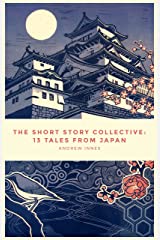THE SHORT STORY COLLECTIVE: 13 TALES FROM JAPAN
by Andrew Innes
Available from Amazon in paperback and ebook formats
Review by Rebecca Otowa
This collection of 13 short stories invites the reader to join the author in a challenging navigation of the seas of reality and fantasy. There are twists, turns and illusions galore, and the stories have many different settings and memorable characters.
Hopefully without spoiling things for anyone, the title story, “The Short Story Collective” (which appeared in Best Asian Short Stories 2021), and the final story, “Anger Management”, are connected by a river which is regularly turned into a drunken festival for the resident giant salamanders when a temperamental sake maker throws out a subpar batch. Between these, we are given a tour of many diverse facets of modern Japanese culture, such as the digitally-driven society, for example in “Miss Representation”, in which a hapless English teacher at a liberal university becomes a victim of “cancel culture” for correcting a student’s grammar; “Veritas”, in which a nefarious secret organization, controlling social media, is responsible for ups and downs in the careers of artists; “Digital Opium”, in which a game creator suffers from terrifying illusions; and “Generation C”, in which a teacher resorts to the latest technology to augment a disguise he has assumed in order to get a job.
Andrew Innes says that some of the stories, such as “The Rotten Mikan”, about an English school that suffers under the wrong boss, and “The Gaijin Parade”, about a small-town International Festival, originate from personal experiences. Others are simply the result of his imagination, and an amazing imagination it is. The fantastic daydreams of some of the characters before they are jolted back to reality are captivating.
My own favorite story was “Pattern Separation”, about an ice-cream company whose routine is so soul-crushingly boring that the workers start experiencing fractures in time. The gradual accretion of time-related disorientations on the part of the workers leads to one of them resorting to a novel action in order to save her own sanity and that of her colleagues. Pandemonium ensues, and we don’t know what really happened until the last line, which reveals the secret of her plan.
As a person who clearly remembers what life used to be like before IT crept into every corner, I liked the description of the farmer who looks to clean up by offering superficial foreign tourists a romp in Nature in “Digital Detox”. And as a person who (like most of us) clearly remembers the problems caused by “overtourism” in Kyoto before Covid, I was carried back to some vicariously embarrassing moments as I read the wince-inducing “When in Rome”, about some YouTuber good-time-Charlies who wreak havoc in the old capital.
One of the most difficult stories for me was “The Koan”, a story of how very unspiritual spiritual pursuits can sometimes be. It wove a web of cynicism that will not soon be forgotten, and ironically, raised the question of how (and whether) a temple-organized, centuries-old ritual ordeal, intended to produce enlightenment, changes the nature of reality for the participant. I guess a story called “The Koan” would understandably be one in which mental contortions are required.
Reading these stories, I was intrigued at how much Andrew Innes expects of the reader, in his rapid alternations between fantasy and reality, and in his subtle foreshadowing technique, which, in many stories, produces an incrementally increasing sense of desperation. These are challenging stories, no doubt about it. They would perhaps fall into a new genre, “Atama no Taiso” (“Mental Exercise”). When you read them, be sure your mental equipment is in good condition.
Also, be ready to be entertained. The large margin by which an arrogant “eco-tourist” misses his own points in “Digital Detox”; the neat way in which an unassuming office worker and her colleagues get the better of an unpleasant boss in “Hole-in-One”; and the broad, happy description of a jovial Australian introducing his culture to rural guests at a small-town “International Festival” by teaching them to say “Where’s me stubby cooler ya dirty drongo?”, as well as other moments, tickle the funny bone.
The Short Story Collective, in short, is quite a ride. Fasten your seat belt.
******************
Andrew Innes came to Himeji in 2002 when the cherry blossoms were in full bloom and the Hanami parties were in full swing. He now works at three universities in Hyōgo and edits the online journal, The Font, where extracts from his book can be found. In his free time, he enjoys hiking and traveling.








Recent Comments